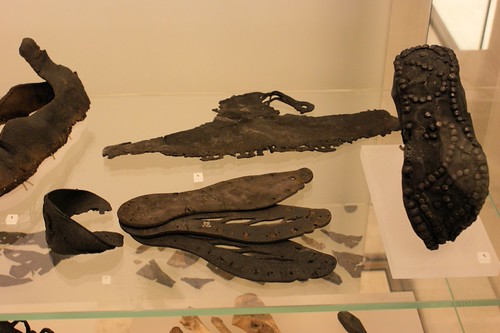There’s a proverbial cow somewhere that’s starting to look nervous…
I’ve finally finished the first cut of the NMS photos. Here for your edification and viewing pleasure is the first lot of leather photos. I’ll do the skeletal materials photos in another post, and I’ve already done the leatherworker’s toolkit elsewhere. Click on them to embiggen if you want a closer view.
The full set of photos contain lots of stone and metalworking as well, I’ll also get the textiles and paint photos up in the Fullness of Time™.
Stone, bronze and iron age

Weaving comb and leather fragments. The triangular piece looks like it might have been from a tent. Newstead, 100-175AD
Embossed and decorated leather chamfron panel, Newstead. 75-100AD
The one-piece shoe on the left is from Newstead (2nd C), the wooden last from Buiston and the two piece shoe from Iona (both 6-8th C). This is one of the problems with the NMS, they group similar items together even though there may be several centuries apart and from different cultures and imply a relationship between the objects that doesn’t necessarily exist.
Multi-part shoes, Newstead 2nd Century AD. There’s at least two and possibly three different styles of shoe here.
Multi-part shoes, Newstead 2nd Century AD. There’s some unrelated leather working tools on the top shelf.
British leatherworking tools. Knives from Cairnholly, Cleughhead, Luce Sands, Traprain Law and Camelon. 7500BC-900AD. At least the dates are fairly obvious on this set, even if it does cover nearly 8000 years. The shoe is from Newstead.
British leatherworking tools. Awls from Ruberslaw, Burrian, Druimvargie Cave, Foshigarry, Knop of Howar, MacArthur Cave, Skara Brae, Torran Dubh, Buiston and Newstead. 8500BC-900AD
Needles from Hillhead, West Grange of Conon and Laws of Monifieth. 300BC-800AD.
Medieval
Leather shoes from the lead mining site at Sillerholes, West Linton, Peeblesshire. 13th to 14th century.
Leather belt pieces and bone awls with off-cuts from leatherworking, from Fast Castle, Berwickshire.
Leather shoe soles. The one on the right is a child’s size. 15-16th century.
Early Modern
Shoe sole detail, Tomb of Mary Queen of Scots. 1606-12. The cut in the sole for hiding the welting [see comment below] sole stitches can be clearly seen.
Large bombard from the 17th century, four layers of leather in the handle, possible traces of red paint on the back edge. H.JS32.
I have some detail photos here.
Scottish Bollock Knives, 17th C
L: With gilt and engraved decoration indicating it belonged to the Master of Home. H.1991.1865.1
R: with scabbard and gilt and decoration on the blade, dated 1617. Scottish, probably Edinburgh. H.LC. 111a and b.
Note the diamond cross-section. Most earlier daggers of this type have triangular cross-section blades.












I think it’s amazing that many of the relics ever survived. Thanks for the post.
Hi Rev,
Enjoyed the latest post regarding the NMoS leathergoods finds – certainly some pieces there that I was not familiar with, so all good info. Got to take issue with your comment on the statue of Mary Queen of Scots though, your comment -” The cut in the sole for hiding the welt stitches can be clearly seen” The line you can see on the sole of the shoe is the trace of the channel cut into the sole leather into which the sole stitches are set, not the welt stitches. The welt in this case is made of a thin piece of leather which is folded and rolled back on itself and then held in place with a bracing thread. The sole stitches then pass through this rolled edge, enter the top surface of the sole leather and finish up in a channel cut into the underside (the surface that touches the ground) of the sole leather. This channel is then closed to cover the sole stitches and leaves the merest trace of a line all around the underside of the sole. The use of the “rolled welt” technique (very common at this tiime) allows the shoemaker to achieve the absolute minimum sole dimensions and facilitates features such as overhanging toes and very narrow waists. What you can see very clearly from the statue is existence of an overhanging toe on mary’s shoe – the trace lines of the toe pleats that result from this technique can also be clearly seen. I hope this helps.
Hi W – great pics as usual!
Have you seen the artifact photos on MoDiP’s web page? There is at least one costrel and one jack (post 1600). In case you have not here is the link: http://www.modip.ac.uk/artefact/wchl-6. I thought you might enjoy them – I did – they are very well photographed from many angles. I only wish every artifact I wanted to look at had photos like these!
Cheers,
Holly
Thanks, that’s a rather nice costrel as well. http://www.modip.ac.uk/artefact/wchl-4
Pingback: National Museum of Scotland – Bone, Horn and Antler Gallery « The Reverend's Big Blog of Leather